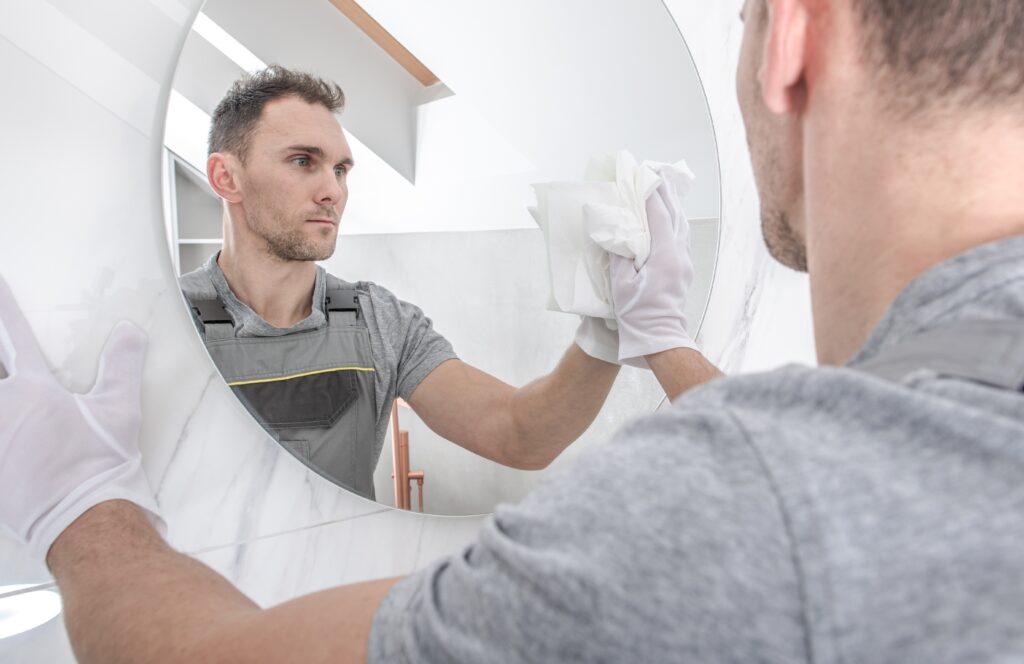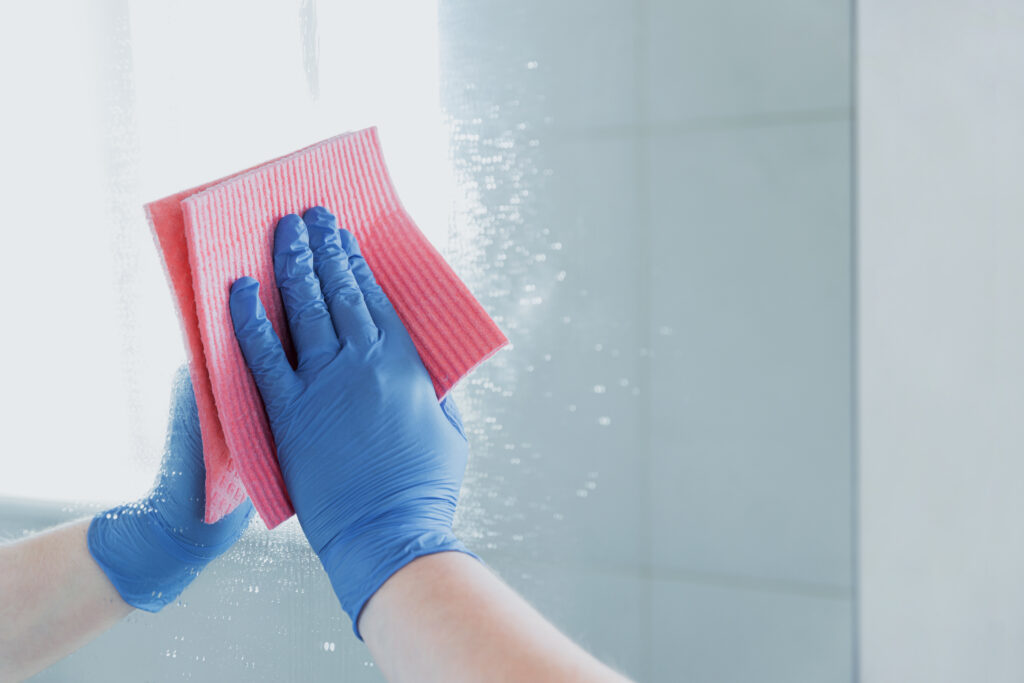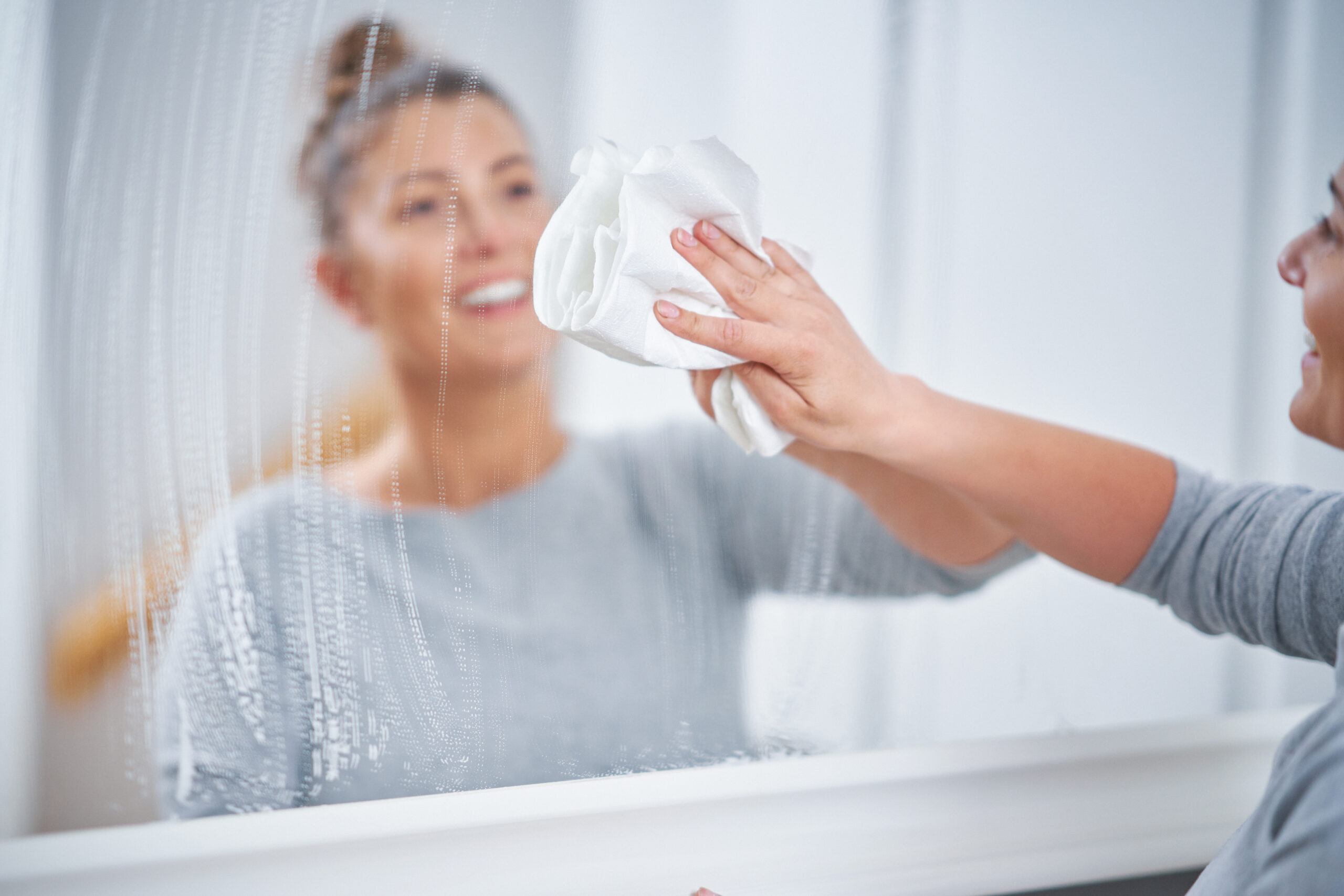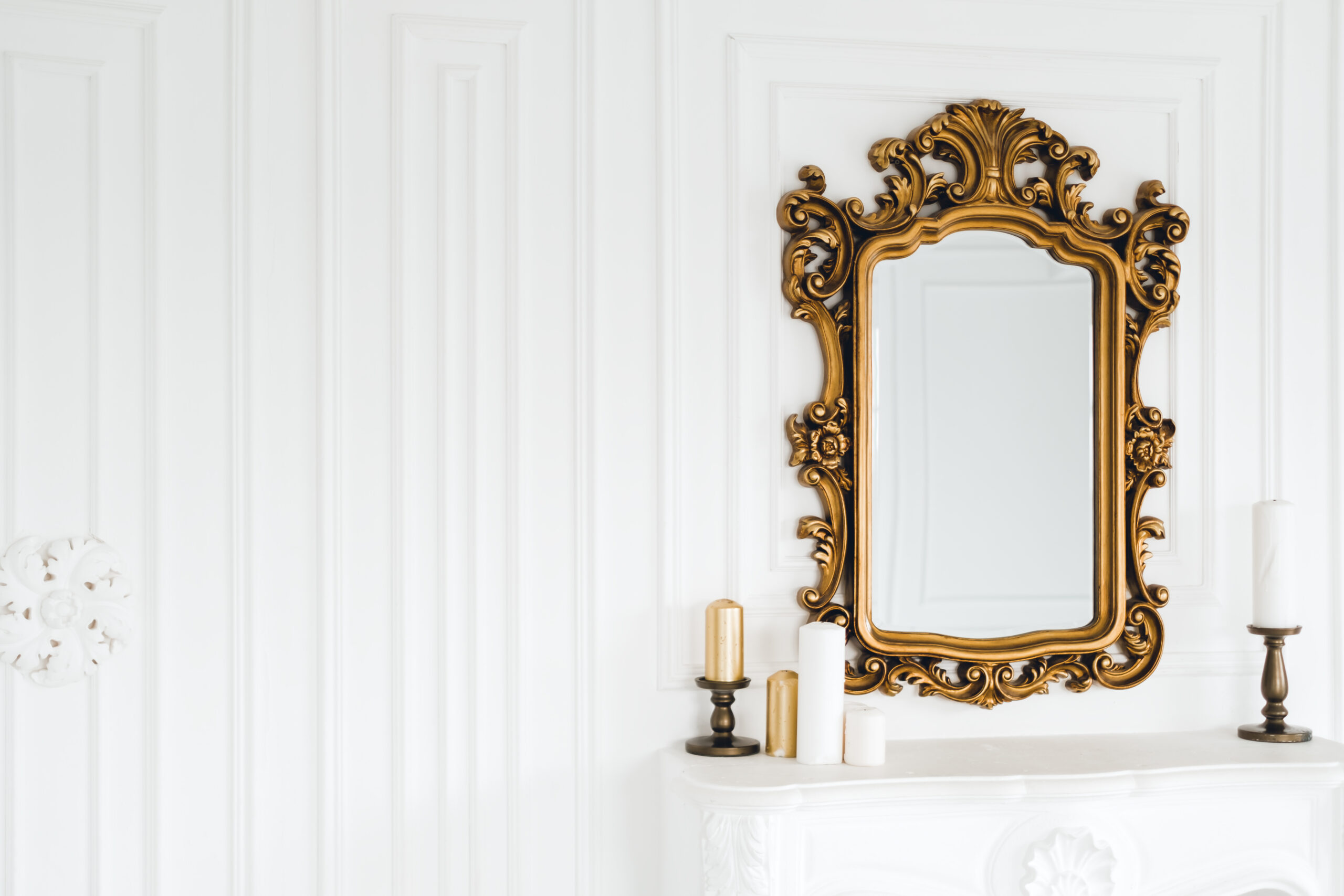How to Clean Mirrors
Mirrors are more than just reflective surfaces; they are essential elements of both home decor and personal grooming. Clean mirrors not only contribute to the overall aesthetics of a room but also play a crucial role in our daily routines. From ensuring your outfit is just right to brighten up a living space, mirrors are versatile.
However, dirty mirrors can quickly become an eyesore, hindering their functionality and tarnishing the beauty of your home. In this article, we will delve into the significance of maintaining pristine mirrors and provide a comprehensive guide on how to clean a mirror effectively in various areas of your home. Say goodbye to smudges, streaks, and cloudy reflections as we equip you with the knowledge and tips to keep your mirrors sparkling.

Collect Tools & Materials Required for Mirrors Cleaning
Cleaning mirrors effectively requires the right tools and materials to achieve that gleaming, spotless finish.
Essential Cleaning Tools
- Microfiber Cloths: These lint-free, soft cloths are perfect for wiping and polishing mirror surfaces without leaving streaks or scratches. (Buy on Amazon.com)
- Squeegee: A squeegee is especially useful for large mirrors, helping to remove cleaning solution and water without smudges.
- Lint-Free Cloth: Similar to microfiber cloths, lint-free cloths are essential for a final wipe to ensure a completely streak-free mirror.
- Old Newspapers: Newspapers, when crumpled and dampened slightly, can act as a substitute for paper towels, leaving mirrors streak-free and lint-free.
- Soft Bristle Brush: A soft brush, like an old toothbrush, can be used to clean intricate or detailed mirror frames and decorative elements.
- Spray Bottle: A spray bottle helps in even distribution of the cleaning solution on the mirror surface.
- Gloves: Optional but recommended, especially when using homemade solutions, to protect your hands from chemicals.
- Goggles: If you’re dealing with commercial cleaners or chemicals, wearing goggles can protect your eyes from splashes.
- Step Stool or Ladder: For cleaning mirrors placed in higher positions, having a step stool or ladder ensures safe and easy access.
- Protective Covering: When cleaning mirrors in bathrooms, consider covering electrical outlets and switches with plastic wrap or tape to prevent water damage.
- Specialized Products for Antique or Decorative Mirrors: If you have antique or ornate mirrors, consider using specialized cleaning products recommended by conservators or antique experts to preserve their finish and value.
Choose the Right Cleaning Solutions
1. Commercial Glass Cleaners:
Use commercial glass cleaners for quick and effective mirror cleaning. Remember to always read and follow the instructions provided with commercial cleaning products, and when using any new cleaning solution.
2. Homemade Solutions:
You can made your own cleaning solutions using household items, like baking soda, vinegar, dish soap, saving money and reducing chemical exposure.
- Vinegar and Water Solution: Mix equal parts of white vinegar and water in a spray bottle. Spray the solution onto the mirror surface and wipe it off using a clean microfiber cloth for a streak-free shine.
- Baking Soda Paste: Mix 2 tablespoons of baking soda with enough water to form a paste. Apply the paste to the mirror using a soft cloth, gently scrubbing in circular motions, then wipe clean with a damp cloth and buff to a shine.
- Lemon Juice and Water Solution: Mix 1 cup of water with 1/4 cup of fresh lemon juice in a spray bottle. Spray the mixture onto the mirror, wipe it down with a microfiber cloth, and polish the mirror to a gleaming finish for a natural citrus-fresh scent.
- Rubbing Alcohol: Rubbing alcohol can be mixed with water to create a quick-drying cleaning solution for mirrors.
- Dish Soap: A mild dish soap mixed with warm water is effective for cleaning mirrors, especially when dealing with greasy or sticky residues.
Master Mirror Cleaning Across Your Home
Explore below for tailored tips on achieving sparkling mirrors in various spaces, ensuring clarity and elegance in your home decor and grooming routine. From bathrooms to bedrooms and living rooms, discover the best practices for mirror maintenance in every corner of your house.
1. How to Clean Bathroom Mirrors?

To clean bathroom mirrors effectively, follow these steps:
- Prepare the Cleaning Solution:
Prepare the cleaning solutions by choosing one of the methods above. Alternatively, you can use a commercial glass cleaner.
- Remove Dust and Debris:
Use a soft, dry cloth or a microfiber cloth to remove dust and loose debris from the mirror’s surface.
- Apply the Cleaning Solution:
Spray the vinegar and water solution or your chosen glass cleaner evenly over the mirror’s surface. Ensure it is adequately moistened but not overly soaked.
- Wipe the Mirror:
Take a clean microfiber cloth or a lint-free paper towel and start wiping the mirror from the top corner, moving horizontally or vertically, in straight lines. Avoid circular motions to prevent streaks.
- Focus on Stains and Spots:
For stubborn spots or toothpaste splatters, spray a bit more cleaning solution on the affected area and gently rub with the cloth until the spot disappears.
- Dry and Polish:
Use a dry, clean microfiber cloth or a second lint-free paper towel to dry and polish the mirror. Wipe in straight lines to remove any remaining moisture and achieve a streak-free shine.
- Check for Streaks:
Inspect the mirror from different angles and lighting to ensure there are no streaks or smudges left behind. If you notice any, re-polish those areas until the mirror is completely clear and shiny.
- Optional: Use a Squeegee (For Larger Mirrors):
If you have a large bathroom mirror, consider using a squeegee after applying the cleaning solution. Starting from the top, pull the squeegee down in a straight line, wiping the blade after each pass. This method helps prevent water spots.
Following these steps will leave your bathroom mirror spotless and gleaming.
Recommended for you: How to Clean a Toilet
2. How to Clean Mirrors in Bedrooms and Living Rooms
Mirrors in these areas may not face toothpaste splatters, but they still need regular cleaning to maintain their shine.

To clean mirrors in bedrooms and living rooms, focusing on areas with fingerprints, smudges, and decorations, follow this procedure:
- Gather your materials: You’ll need a microfiber cloth, a commercial glass cleaner or a homemade solution (such as vinegar and water), and a lint-free cloth.
- Dust the mirror: Start by gently dusting the mirror’s surface to remove loose particles and debris. Use a dry microfiber cloth for this step.
- Spray the cleaning solution: If using a commercial glass cleaner, spray it evenly on the mirror’s surface. Alternatively, if using a homemade solution, apply it sparingly using a spray bottle.
- Wipe the mirror: Using the microfiber cloth, begin wiping the mirror in a horizontal or vertical motion, depending on your preference. Focus on areas with fingerprints and smudges, applying a bit more pressure if needed.
- Detail the edges and corners: Pay special attention to the edges and corners of the mirror, where dust and smudges tend to accumulate. Use the edge of the cloth to reach into these areas.
- Check for streaks: After cleaning, inspect the mirror for streaks. If you notice any, reapply the cleaning solution and gently buff the affected areas with a lint-free cloth until the streaks are gone.
- Polish the mirror: To achieve a sparkling finish, use a clean, dry lint-free cloth to polish the mirror’s surface in circular motions. This step helps remove any remaining residue and ensures a clear reflection.
- Address decorations: If there are decorations on or around the mirror, use a separate cloth or a gentle touch to clean them as needed, being cautious not to damage any delicate or intricate pieces.
By following this procedure, you can effectively clean mirrors in bedrooms and living rooms, removing fingerprints, smudges, and maintaining the beauty of any decorative elements surrounding the mirror.
Having achieved sparkling mirrors for an impeccably polished bedroom, now indulge in the next level of blissful comfort – discover the secrets to pristine pillows with our guide on “How to wash pillows?“
Identifying Appropriate Cleaning Solutions for Different Mirror Types
Mirrors are not one-size-fits-all; they come in various materials and finishes. Understanding these differences is crucial for effective cleaning. Using the right cleaning solution is vital to prevent damage and maintain the longevity of mirrors. Here, we explore suitable options for various mirror surfaces.
1. Glass Mirrors
Common in households and easy to clean, glass mirrors require regular maintenance to prevent streaks and smudges.
How to Clean Glass Mirrors
Commercial glass cleaners are effective for routine cleaning. They are designed to remove smudges and leave a streak-free shine. Homemade solutions like a mixture of water and mild dish soap can also work well, providing a budget-friendly alternative.

2. Antique Mirrors
Antique mirrors are delicate and often have intricate designs. Specialized cleaning methods are necessary to preserve their vintage charm without causing damage.
How to Clean Antique Mirrors?
Specialized glass cleaners designed for delicate surfaces should be used. Alternatively, a mixture of water and white vinegar can be gently applied with a soft cloth to maintain the antique mirror’s integrity.

3. Fog-Resistant Mirrors
Typically found in bathrooms, fog-resistant mirrors have coatings that prevent condensation. Cleaning them requires specific techniques to avoid damaging the fog-resistant properties.
How to Clean Fog Resistant Mirrors
Mild, non-abrasive cleaners are recommended to preserve the fog-resistant coating. Avoid using harsh chemicals, which can damage the fog-resistant properties.

Tips for Maintaining Mirrors in Homes and Bathrooms
- Regular Cleaning Routine:
Establish a consistent cleaning schedule for mirrors in both homes and bathrooms to prevent the buildup of dirt, grime, and water spots.
- Gentle Cleaning Solutions:
Use mild, non-abrasive cleaning solutions to avoid damaging the mirror surface. Homemade solutions like vinegar and water or commercial glass cleaners work well.
- Avoid Harsh Abrasives:
Refrain from using abrasive materials or harsh chemicals, as they can scratch or deteriorate the mirror’s reflective coating.
- Prevent Water Damage:
Wipe off water splashes and droplets promptly, especially in bathrooms, to prevent water damage and the formation of stubborn water spots.
- Mind the Frame:
Pay attention to cleaning not just the mirror surface but also the frame (if applicable). Delicate frames should be cleaned with care to avoid damage.
- Ventilation is Key:
Ensure proper ventilation in bathrooms to minimize condensation and prevent mirrors from fogging up. Consider installing exhaust fans if necessary.
- Avoid Hanging Items Directly:
Avoid hanging wet or damp items directly on mirrors, as the moisture can seep into the edges and cause damage over time.
- Handle with Care:
Be gentle when cleaning decorative mirrors or those with intricate designs. Use a soft cloth and gentle strokes to clean delicate surfaces.
- Regular Inspections:
Periodically inspect mirrors for any signs of damage, discoloration, or peeling. Early detection allows for timely repairs or replacements.
- Professional Maintenance:
For antique or valuable mirrors, consider professional cleaning and maintenance services to ensure they are handled with expertise and care.
By following these tips, homeowners can maintain the clarity and beauty of mirrors in both their homes and bathrooms, ensuring they remain functional and visually appealing for years to come.
FAQs Related to Mirror Cleaning:
A: To prevent fogging, wipe the mirror with shaving cream and then buff it with a clean, dry cloth. Alternatively, increase ventilation in your bathroom to reduce moisture buildup.
A: While vinegar is effective for many mirrors, it might damage antique mirrors. Consult a professional for antique mirror cleaning to ensure their preservation
A: Mix equal parts of water and rubbing alcohol, dampen a cloth, and gently rub the stains. Wipe the mirror clean with a microfiber cloth afterward.
A: Mirrors in living rooms should be cleaned every two weeks to maintain their clarity and shine.
Comparing Professional Mirror Cleaning Services vs DIY Cleaning Services:
Professional mirror cleaning services offer several advantages that DIY cleaning often can’t match:
- Expertise and Experience: Professional cleaners possess the expertise to handle various mirror types, ensuring delicate and antique mirrors receive specialized care.
- Specialized Equipment: Professionals use specialized tools and equipment to clean mirrors effectively, ensuring a streak-free finish and minimizing the risk of damage.
- Customized Solutions: Professionals tailor their approach based on the mirror type, ensuring the right cleaning products and techniques are applied for optimal results.
- Time and Effort: Hiring professionals saves you time and effort. They complete the job efficiently, allowing you to focus on other tasks.
- Long-Term Preservation: Professionals not only clean but also assess the mirror’s condition, identifying potential issues early, which can help preserve mirrors in the long run.
- Insurance and Guarantee: Reputable professional services often provide insurance coverage and guarantees, offering peace of mind regarding any potential damages during the cleaning process.
In summary, while DIY cleaning methods are suitable for regular maintenance, professional mirror cleaning services offer a comprehensive, expert-level approach that ensures mirrors are not only clean but also well-maintained and preserved over time. Opting for professional services can save you hassle and ensure the longevity of your mirrors, making them a valuable investment for your home.
Explore More: How to Remove Oil Stains from Walls.
